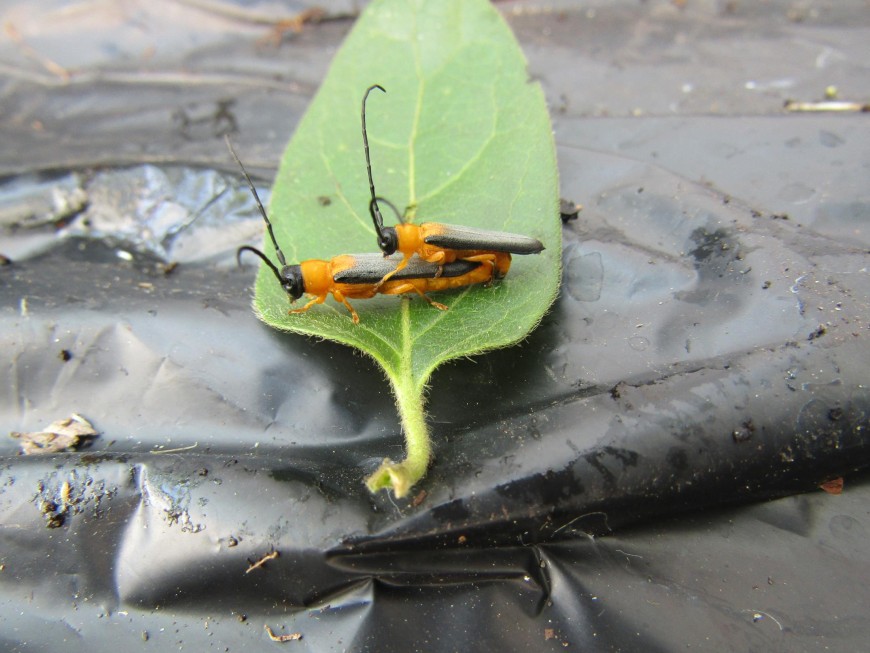Japanese honeysuckle stem beetle
History in New Zealand
The Japanese honeysuckle stem beetle is native to Japan. It was first imported by Manaaki Whenua - Landcare Research into containment for testing in 2010. The testing was completed in 2015 and permission to release the beetles was granted by the EPA later that year. The first field release was made in 2018. Once numbers build up, the beetles will be redistributed to other parts of the country where Japanese honeysuckle is problematic. The Japanese honeysuckle stem beetle has not been used as a biocontrol agent anywhere in the world before. This is the second agent released to attack Japanese honeysuckle in New Zealand.
How would I find/recognise them and what is their lifecycle?
Adult beetles emerge in the spring and early summer and begin to feed on the leaves of Japanese honeysuckle.

Image: adult Japanese honeysuckle stem beetles.
This feeding damage on leaves is quite distinctive. Adults are around 1.5-2 cm long and may be seen flying about Japanese honeysuckle infestations or resting on leaves. Adults have an orange thorax and legs, velvet black antennae and a steel blue wing cover on their back, while the underside and abdomen are also orange. Males and females are similar in appearance.
Females lay eggs inside the stems so the eggs cannot easily be seen. The eggs hatch after about a week and the resulting creamy-coloured larvae feed inside the stems. Their frass, which looks like sawdust, can sometimes be found on the outside of stems. Pupation occurs inside the stem and once completed, new adults emerge from holes in the stems.
Image: oviposition hole in a Japanese honeysuckle stem.
Image: stem beetle larva.

Image: stem beetle larva.
The adults can live for up to a month and the females lay around 50 eggs over a 2–4-week period. There is one generation per year.

Image: adult stem beetles.
How do they damage Japanese honeysuckle?
Adult feeding damage on leaves is largely cosmetic. The main damage is done by larvae which feed inside stems. Heavily infested stems can be killed by larval feeding.
Image:stem beetle characteristic feeding damage.

Image:stem beetle characteristic feeding damage.
Will they attack other plants?
The stem beetle is a Japanese honeysuckle (Lonicera japonica) specialist. In no-choice oviposition tests, a few eggs were laid on some ornamental honeysuckles (e.g. Lonicera ‘’Graham Thomas’ and Lonicera ‘Gold flame’) as well as Himalayan honeysuckle (Leycesteria formosa) but these species did not support larval development. The stem beetle is not able to attack the most commonly grown ornamental honeysuckle Lonicera nitida. The beetle may not be completely monophagous: there is a host-record from Lonicera morrowii in Japan, although it is not clear if this was adult or larval feeding. Adult beetles can feed on a slightly larger range of plants than larvae and may potentially cause cosmetic damage on some garden ornamentals that are closely related to Japanese honeysuckle, such as Weigela.
How effective are they?
It is too soon to know what impact the beetle will have here but field observations in Japan have shown that the larvae can be extremely damaging to Japanese honeysuckle by killing large stems. Few parasitoids, that are likely to attack the beetle, are believed to be present in New Zealand.
How can I get the most out of this agent?
If the stem beetle establishes at initial release sites, it would be worth helping to establish them in all areas where they are needed. The adults can fly and will disperse over time but helping to shift them about will speed up the process.
How do I select a release site?
Read Guidelines for selecting release sites for biocontrol agents.
How do I collect them for release at other sites?
During the early summer months, use a net to collect adults flying about or sitting underneath Japanese honeysuckle leaves, and transport them on some foliage in a chillybin to their new home. You should aim to shift at least 50 adult beetles, preferably more. At the new site, open the container and let the beetles fly away onto the Japanese honeysuckle plants.
How do I manage the release sites?
Avoid any activities that will interfere with the stem beetle, such as herbicide application. If you need to undertake control measures then avoid the release site.

